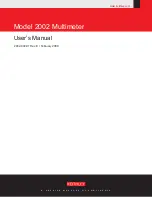
Continuity Test
The continuity function detects intermittent opens and shorts lasting as little
as 1 millisecond. These brief contacts cause the meter to emit a short beep.
This function is convenient for checking wiring connections and opera t i o n s
of switches. A continuous tone indicates a complete wire or connection.
CAUTION!
Using resistance and continuity function in a live circuit will produce
false results and may damage the instrument. In many cases the suspi-
cious components must be disconnected from the circuit under test to
obtain accurate results.
The
1mS Pe a k
,
MIN/M AX
and
REL
∆
functions are not available when
c o n t i n u i ty is selected
Conductance for High Resistance Tests
Conductance is the reverse of resistance, and is the ability of a circuit to
pass current. High values of conductance correspond to low values or
resistance. The unit of conductance is the Siemens (S).
Capacitance Measurement
CAUTION!
To avoid damaging the meter or the equipment under test, remove all
power from the circuit and discharge all high-voltage capacitors before
measuring capacitance. Large value capacitors should be discharged
through an appropriate resistance load. use the DC voltage function to
confirm that the capacitor is discharged.
The available capacitance ranges are 5nF, 50nF, 500nF, 5µF, 50µF, 50 0 µ F ,
and 5mF (5000 microfara d s ) .
Tips for measuring ca p a c i t a n c e :
• To speed up measurements of similar values, press “
RANGE
”
push-button to manually select the proper range
• To measure small values of capacitance accurately, press “
REL
∆
“
push-button with the test leads open to subtract the residual
capacitance of the meter and test leads
Diode ( ) Test
CAUTION!
D i s c h a rge all high - v o l t a ge capacitors before testing diodes. La rge value
capacitors should be discharged thro u gh an appropriate resistance load.
Use the diode test to check diodes, transistors, silicon controlled rectifiers
( S CRs), and other semiconductor devices. The test sends a current
through a semiconductor junction, and then measures the junction’s volt-
age drop.
Forward Biased Reading:
Normal forward voltage drop (forw a r d i n g
biased) for a good silicon diode is between 0.4V and 0.9V. A reading high-
er than that indicates a leaky (defective) diode. A zero reading indicates a
shorted (defective) diode. A reading of “
o FL
” indicates an open diode
( d e f e c t i v e ) .
Reverse Biased Reading:
Reverse the test leads across the diode. The
display should show “
o FL
” if it is good. Any other readings indicate the
diode is shorted or resistive (defective).
Temperature (Temp) Measurements
WARNING!
Do not apply thermocouple to circuits exceeding 30V RMS 42.4V peak or
60V DC.
*Use the ATT70, Temperature probe adapter with standard K-type thermocouples.
Observe proper polarity.
Current ( , ) Measurements
WARNING!
Never attempt an in-circuit current measurement where the open-circ u i t
potential to earth is greater than 10 0 0 V. You may damage the meter or
be injured if the fuse blows during such a measure m e n t .
CAUTION!
Check the meter fuses before measuring current. Use the proper termi-
nals, function, and ra n ge for current measurements. Never place the
p robes in parallel with any circuit or component when the test leads are
p l u gged into the current terminals.
The available current ranges are 500.00µA, 5000.0µA, 50 . 0 0 0 m A ,
500.00mA, 5.0000A and 10 . 0 0 0 A .
*I RMS = (AC+DC total RMS amps)
DM397-MAN
P. 8
Measurement
Diode
Menu key
(no selection)
Connect Le a d s
P r i m a ry Display
V
S e c o n d a ry Display
-
Measurement
Celsius Temp.
(default)
Fahrenheit
Temp.
Menu key
(no selection)
SET
Connect Le a d s
P r i m a ry Display
C
F
S e c o n d a ry Display
-
-
Measurement
True RMS
AC Amps
(default)
DC Amps
AC+DC
Total RMS
AC/DC
Dual Display
Menu key
(no selection)
DC
AC+DC
or
AC/DC
(press to tog-
gle)
Connect Le a d s
P r i m a ry Display
A C
D C
A C + D C
A C
S e c o n d a ry Display
H z
-
H z
D C

































